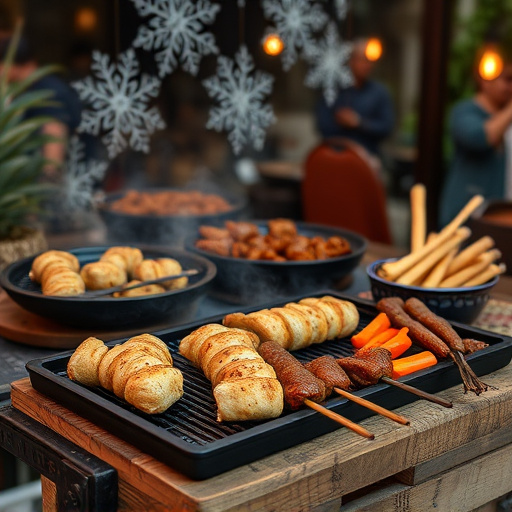Master the art of crafting a mouthwatering BBQ ham using the "low and slow" cooking technique. This method involves cooking ham at low temperatures (200-250°F / 93-121°C) for an extended period, breaking down collagen to create juicy, tender meat. Essential steps include brining, seasoning with coarse salt and spices, and smoking with wood chips for flavor enhancement. Resting the ham post-cooking ensures moisture redistribution, leading to a delicious, tender BBQ ham experience.
Discover the art of crafting a perfectly juicy ham with our comprehensive guide to the low and slow cooking method. Learn how this technique, popular among BBQ enthusiasts, transforms tough cuts like ham into tender, flavorful delights. From brining for maximum moisture retention to smoking techniques that add depth, we break down every step. Equip yourself with the right tools and secrets to create a mouthwatering bbq ham recipe that’s sure to impress.
- Understanding the Low and Slow Cooking Method
- Why This Technique is Perfect for Ham
- The Essential Equipment You'll Need
- Brining the Ham: A Key Step for Juicy Results
- Seasoning and Spices: Creating a Flavorful Profile
- Smoking the Ham: BBQ Techniques to Achieve Tender Meat
- Letting It Rest: The Final Touches for Optimal Juiciness
Understanding the Low and Slow Cooking Method
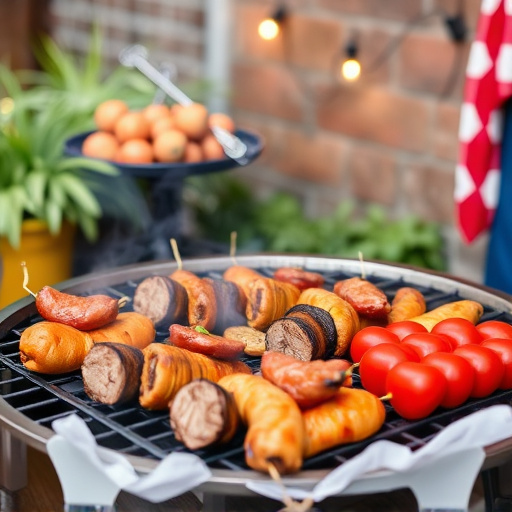
The “low and slow” cooking method is a time-honored technique that transforms tough cuts of meat, like ham, into melt-in-your-mouth delicacies. This approach involves cooking the ham at low temperatures for an extended period, allowing its collagen to break down and produce a succulent, juicy result. For a mouthwatering BBQ ham recipe, this method is unparalleled. By maintaining a consistent temperature around 200-250°F (93-121°C), the ham slowly renders its fat, infusing every bite with rich flavor.
This slow and steady process ensures that the ham stays moist and tender, with minimal risk of overcooking or drying out. The low heat gently breaks down the muscle fibers, resulting in a texture that’s both delicate and satisfyingly chewy. Whether you’re a BBQ enthusiast or simply looking to elevate your Sunday roast, embracing the low and slow method for your next ham dish will undoubtedly impress your taste buds.
Why This Technique is Perfect for Ham
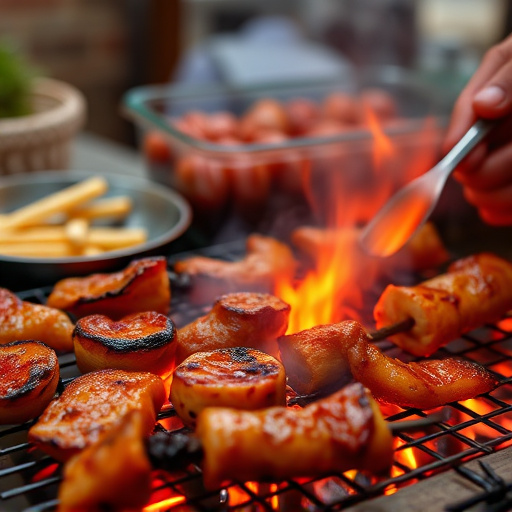
The “low and slow” cooking technique is ideal for preparing juicy, flavorful BBQ ham. This method involves cooking the ham at a low temperature for an extended period, allowing it to retain its natural moisture and develop a rich, complex taste. Unlike faster cooking methods that can dry out the meat, low and slow ensures the ham stays tender and succulent, making it perfect for a BBQ ham recipe. The gradual heat penetration breaks down connective tissues, resulting in a melt-in-your-mouth texture that’s highly desirable for this classic dish.
The Essential Equipment You'll Need

To master the low and slow cooking method for a juicy BBQ ham, you’ll need some essential equipment. This traditional approach requires patience, but the results—a tender, flavorful ham—are well worth the wait. Start with a reliable smoker or oven that allows precise temperature control, as consistency is key to success. You’ll also need a good quality ham, preferably with a thick layer of fat, which acts as natural moisture and flavor retainers.
Don’t forget essential tools like a meat thermometer to monitor the internal temperature, ensuring it reaches the perfect level for a melt-in-your-mouth texture. A set of tongs or a spatula is crucial for handling the ham without causing damage or losing precious juices. And finally, prepare your favorite BBQ sauce in advance—it’s the cherry on top that’ll elevate your ham from good to outstanding in any BBQ ham recipe.
Brining the Ham: A Key Step for Juicy Results

Brining is a critical step in the low and slow cooking method for achieving juicy, flavorful BBQ ham. It involves submerging the ham in a solution of salt, sugar, and spices for an extended period before cooking. This process helps to break down the meat’s proteins and absorb moisture, resulting in a tender, succulent ham. A good brine not only enhances taste but also ensures even cooking throughout the meat.
When brining BBQ ham, it’s essential to use a ratio of about 1 tablespoon of salt per cup of water, along with sugar and other spices like peppercorns, mustard seeds, and garlic for added depth. The ham should be fully submerged in the brine, and the solution should be refreshed every few days to maintain its effectiveness. This step is crucial for locking in juices during the slow-cooking process, ensuring a mouthwatering, tender ham that’s sure to impress.
Seasoning and Spices: Creating a Flavorful Profile

When it comes to crafting a juicy, mouthwatering BBQ ham recipe, seasoning and spices play a pivotal role in developing a complex flavor profile. The key is to balance sweetness, saltiness, and heat for a harmonious blend that elevates the ham’s natural taste. Start with a generous coating of coarse salt, which not only enhances flavor but also helps draw out moisture, ensuring your ham stays juicy during the slow-cooking process.
Consider adding spices like peppercorns, garlic powder, paprika, and a touch of cayenne for depth and warmth. These ingredients contribute to a robust, smoky taste that’s characteristic of BBQ ham recipes. Don’t be afraid to experiment with different ratios to suit your palate. Herbs such as thyme, rosemary, and oregano can also add layers of aroma and flavor, creating a truly memorable culinary experience.
Smoking the Ham: BBQ Techniques to Achieve Tender Meat
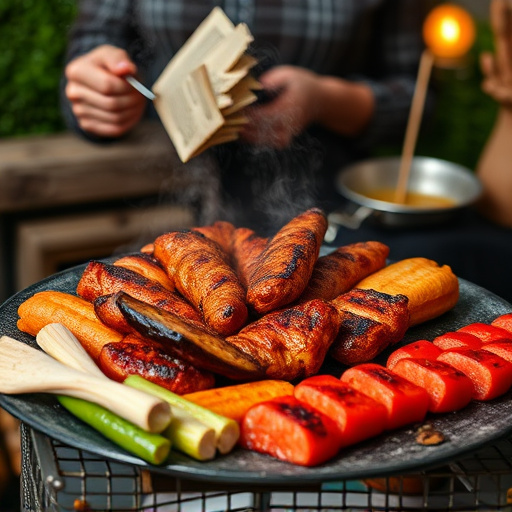
Smoking is an art that elevates a simple BBQ ham recipe from good to extraordinary. It imparts a unique flavor profile, tenderizing the meat and adding depth that can’t be achieved through traditional cooking methods alone. The process involves carefully controlling temperature and heat sources, usually wood chips or chunks, to create a low-and-slow environment. This method allows for the gradual release of moisture, ensuring the ham stays juicy throughout.
For optimal results, start with a good quality ham, ideally one with a thick layer of fat that will render into delicious crackling. Preheat your BBQ to around 225°F (107°C), then smoke the ham for approximately 1 hour per pound. Use hickory or apple wood chips for a subtle yet distinctive taste. Regularly baste with a combination of honey, mustard, and a touch of vinegar to keep it moist and add a sweet-savory glaze. The end result is a perfectly smoked ham that’s fall-apart tender, with a crispy exterior and juicy interior – a true delight for any BBQ enthusiast.
Letting It Rest: The Final Touches for Optimal Juiciness
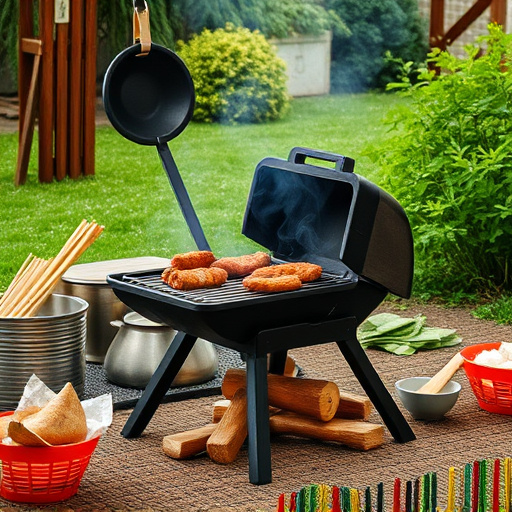
After slowly cooking your ham to perfection, the next crucial step is letting it rest. This resting period allows the juices to redistribute throughout the meat, ensuring every bite is juicy and flavorful. Typically, let the ham rest for about 15-20 minutes per pound, or until the internal temperature drops to around 145°F (63°C). This process is essential in a BBQ ham recipe as it enhances the overall taste and tenderness of the dish.
During this resting time, keep the ham covered loosely with foil to prevent over-drying. The gentle warmth will gently tenderize the meat further, creating a melt-in-your-mouth experience. Once rested, slice the ham thinly against the grain, which ensures a tender texture and makes it easier for juices to stay locked in, keeping your BBQ ham recipe irresistibly juicy.
